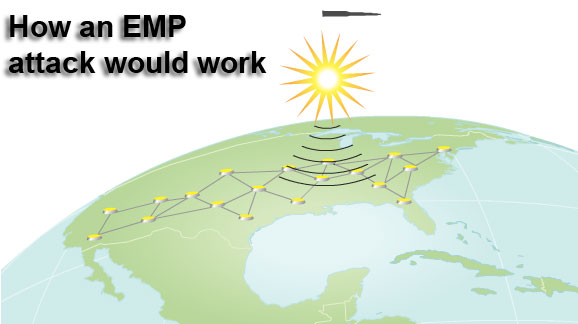
I was tinkering with some common threats this morning and the time quite got away from me. I really wanted to be writing about pastel cars or something practical, but this one has been bugging me.
There are only a few things that are more dangerous that major weather events, which can create short-term paralysis and long-term damage to the nation’s infrastructure. Full scale nuclear warfare seemed to be a diminishing threat, since the reality of Mutually Assured Destruction (MAD) ensured there would be no winners in such an event. A more probable scenario is an attack conducted with a device that generates electromagnetic pulse (EMP).
Here is how it would work. The attack is executed by exploding a single nuclear bomb 200-300 miles above Kansas. It would expose most of the North American continent to a burst of gamma rays in line-of-sight of the blast. There would be little kinetic damage, since the bomb was exploded in the vacuum of space, hundreds of miles above the surface. It would have a direct and devastating result though, since the first casualty would be the electric grid and the large distribution transformers that connect it.

The attack would also create widespread damage to computerized equipment. Today, most all infrastructure is controlled by computers. An EMP attack could take out the water, sewage, food distribution, ATMs, credit cards, transportation, etc. The result could be to place much of the population in immediate and desperate circumstances.
The EMP threat is enshrined in military doctrine, and used to be tested on military equipment prior to the end of below-ground tests at the Nevada Test Site. The last four extra-atmospheric nuclear tests took place in the 1960s: one conducted by the Americans and three by the Soviets. The American test was over the Pacific Ocean, while the Soviets conducted their series over land. Widespread disruptions resulted from the latter.
Other malign non-state actors know about the capability, too.
When the last baseline information was collected in the 1960s, semiconductors and computers were in their infancy. Now computers are everywhere, and semiconductors have processing features smaller than the wavelength of light. The microscopic scazle of these circuits make them fragile and subject to failure under electromagnetic attack.
An EMP attack is within reach for Iran, North Korea, and a variety of non-state actors. While the first two may have considerations for regime continuity, the latter does not. Attribution could be very difficult. While US nuclear forces and some military equipment have long been hardened against an EMP, there is no question that many critical systems would collapse.
An illustrative scenario shows how this massive damage could be inflicted on the cheap. The first thing required is acquisition of a lightweight atomic device with plentiful gamma ray emission. Leaving off the heavy metal casing intended to increase yield, the device might weigh as little as 200 pounds. An intercontinental missile is still the purview of the nation-state; however, a relatively small and cheap commercial sounding rocket can carry a two-hundred pound payload to an altitude of 300 miles. Launch of such a rocket from Norwegian territory in 1995 caused the Russian nuclear warning system to register “attack imminent” warnings and nearly triggered a nuclear exchange.
A sounding rocket can be carried by truck and assembled in a rural area in Kansas. With the exception of the device itself, this is distinctly low-tech. All that is required is a altimeter fusing device that will detonate the bomb at the desired altitude.
The equipment could be smuggled into the country in containers or offloaded from a freighter at night. A terrorist organization might have surreptitious help from the likes of Iran.
Our military might retain some operational capabilities in the post-attack phase, but it is certainty that Citizen Doe will not.
Copyright 2015 Vic Socotra
www.Vicsocotra.com
Twitter: @jayare303
